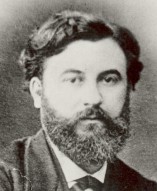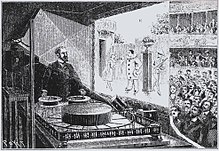Émile Reynaud
Charles-Émile Reynaud (born December 8, 1844 in Montreuil , Département Seine-Saint-Denis , † January 9, 1918 in Ivry-sur-Seine ) was a French photographer, draftsman and French teacher. He was the inventor of the praxinoscope , the théâtre optique , the non-photographic cartoon game and the forerunner of cinematography .
biography
Émile Reynaud learns precision mechanics in the workshop of his father, a steel engraver and watchmaker. With his mother, who was a watercolorist and a student of Pierre-Joseph Redouté, he adopted drawing techniques that would later be useful to him. At the age of 13 he built a shadow theater with a miniature steam engine on top.
In 1858 he joined the Adolphe Gaiffe house in Paris as an apprentice, where he had to repair, build and adjust optical and physical instruments. He then worked for the portraitist Adam-Salomon, where he retouched photographs, and eventually became a photographer himself in Paris.
In 1864 he followed the public courses at the adult education center, namely slide lectures by the Abbé Moigno. He becomes his assistant and learns the profession of lecturer. His course is very popular. At the same time he took part in the illustration of the Dictionnaire général des sciences théoriques et appliquées by the French professor and naturalist Adolphe Focillon.
After the death of his father in 1865, Émile Reynaud and his mother returned to Puy-en-Velay, the cradle of the family, where he held his own scientific meetings. These conferences are a success with the residents of Puy, who can experience the magic of crystallizing salt on a large screen.
In December 1877 he traveled to Paris again to set up at 58 Rue Rodier in the ninth arrondissement. There he devotes himself to the construction, sale and further development of his praxinoscopes.
He married Marguerite Rémiatte in Paris on October 21, 1879. They have two sons, Paul (1880) and André (1882).
In 1888 Émile Reynaud completed his Théâtre Optique , with which he presented to the public of the Grévin Museum from October 28, 1892 on veritable short animated games, which are called light mimes. By March 1900, over 500,000 people had seen these projections. The cartoon game was born, but it wasn't until Émile Cohl in 1908 that it became technologically advanced. 2015, the last two of these works received from were UNESCO for World Soundtrack Awards explained.
With the advent of the Lumière cinematograph from 1895, the end of performances in the Grévin Museum and the decline of his Praxinoscope manufacturing company, Émile Reynaud sells part of his material for copper and wood. Between 1910 and 1913 he destroyed his tapes, of which only “Pauvre Pierrot”, “Autour d'une Cabine” and fragments of other tapes were spared. The latter were restored and presented for the 100th anniversary of the optical theater in 1992.
On March 29, 1917, he was taken to the Ivry Hospital for the Incurable as a victim of pulmonary congestion. He stayed there until his death on January 9, 1918.
His inventions
- The Praxinoscope from 1876 shows animation in a circle over a mirror rim in the middle. He continues to improve it.
- The toy praxinoscope from 1877 is a small praxinoscope whose animation for children contains only eight drawings.
- The theater praxinoscope from 1879 allows a viewer to see a repetitive animation in a fixed configuration.
- The projection praxisinoscope from 1880 enables the representation of a repetitive animation in a fixed decoration on a screen.
- The optical theater from 1889 allows the projection of animations of different lengths and duration in a fixed setting, namely via two magic lanterns . In the Musée Grévin, Reynaud was accompanied on the piano by Gaston Paulin, who composed the music.
- The stereocinema of 1907 produced moving photographs in relief.
literature
- Dominique Auzel: Émile Reynaud et l'image s'anima. Biography with color photographs . Editions du May, 1992 ( ISBN 2-906450-72-3 ); with black-and-white photographs, Dreamland éditeur, 2000 ( ISBN 2-910027-37-6 )
- Herbert Birett: Silent Film Music. Material collection. Berlin: Deutsche Kinemathek 1970
- Herbert Birett: plays of light. The cinema in Germany until 1914. Munich: Q-Verlag 1994
Web links
Individual evidence
- ^ The moving picture shows of Émile Reynaud. UNESCO Memory of the World, accessed September 1, 2017 .
| personal data | |
|---|---|
| SURNAME | Reynaud, Émile |
| ALTERNATIVE NAMES | Reynaud, Charles-Émile |
| BRIEF DESCRIPTION | French photographer, draftsman and French teacher |
| DATE OF BIRTH | December 8, 1844 |
| PLACE OF BIRTH | Montreuil |
| DATE OF DEATH | January 9, 1918 |
| Place of death | Ivry-sur-Seine |

